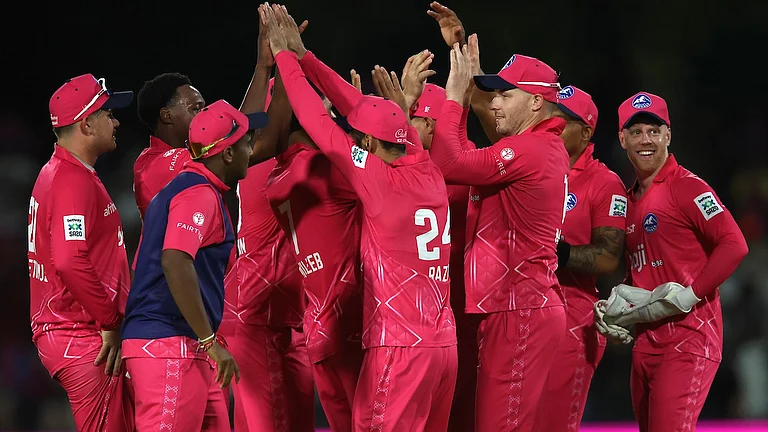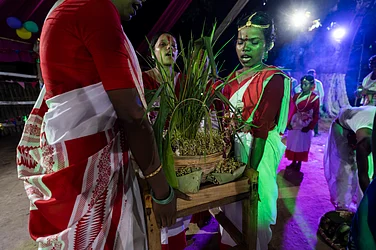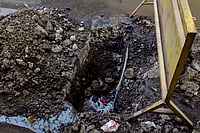Sunan Gogoi alias Mrityunjoy Maladharia's mission did not succeed. This hardcore militant belonging to theseparatist United Liberation Front of Asom's (ULFA) crack Myanmar-based '28th Battalion' had just arrived lastfortnight in Tinsukia district, in Assam, when he fell into the police dragnet. Sunan has since disclosed topolice and intelligence officials interrogating him that ULFA's '28th Battalion', also known as the 'KashmirCamp,' was alive and kicking with its 150-member specially-trained hit-squad.
This information suggests that ULFA had, in fact, never disbanded or 'de-grouped', in the first place in mostlocations where its cadres have been based, and it was, consequently, wrong for the security forces oranalysts to link the recent spurt in violence by the rebel outfit as signs of its 'regrouping'. After theBhutanese military assault on the ULFA and other Northeast Indian rebels based in the Himalayan kingdom, itwas generally thought that the militants had lost their staging areas and had ceased to act as a cohesiveforce thereafter. But, the 'Kashmir Camp', it appears, filled the void after the ULFA rebels were expelledfrom Bhutan, with reports stating that several of the rebels had landed up in Myanmar, and joined theMyanmar-based unit after being thrown out by the Bhutanese military.
Led by dreaded ULFA leader Jibon Moran, the 'Kashmir Camp' is located in part at the Council Headquarters ofthe Naga guerrilla group, the National Socialist Council of Nagaland - Khaplang faction (NSCN-K), and anadvance camp closer to Assam, based at what the rebels call '04'. This advance camp has a bomb squad attachedto it. Top intelligence officials disclose that the '28th Battalion' operates with an estimated 90 AK seriesassault rifles, universal machine guns and some rocket propelled grenades and two inch mortars. Moran, theofficials said, himself operates out of the NSCN-K 'Council Headquarters' with 25 of his carefully chosenrebel cadres.
During the past 19 days, beginning June 9, 2004, ULFA rebels have struck five times in Assam - the group hasbeen seeking 'liberation' of the State since its formation on April 7, 1979 - killing seven people, allcivilians, and injuring at least 52 others. Three of these five attacks were carried out in the eastern teagrowing district of Tinsukia, 550 kilometres from Guwahati, the State capital, and bordering the adjoiningState of Arunachal Pradesh, which in turn has a heavily wooded and porous border with Myanmar. The threeattacks in the Tinsukia district, the area in Assam closest to the 'Kashmir Camp', include:
June 9: A Chinese-made grenade was used to attack movie goers inside the Paradise Cinema, in downtown Tinsukia, justas the Hindi film Aan had begun around 1.30 PM. A total of 23 people, all seated on the ground floor ofthe theatre, were injured.
June 19: An improvised explosive device went off at a public toilet at the crowded Chamber Road, in the heart ofTinsukia town, injuring 13 people, five of them seriously.
June 19: A coal-laden goods train was blown up near Ultapool railway station, close to the oil town of Digboi, around9.15 PM, leading to eight bogies jumping rails and injury to one of the train's two drivers.
Slowly, the ULFA attacks spread to other districts. On June 21, a telephone exchange of the state-run BharatSanchar Nigam Limited (BSNL) was blown up with a timed device at the small town of Tengakhat, in Dibrugarhdistrict, also in eastern Assam. If these four blasts, in quick succession, rattled the police, paramilitaryand the Army, engaged in counter-insurgency operations in Assam under a unified command, the explosion insidea moving private passenger bus in the district of Sivasagar, bordering Nagaland, on June 24, 2004, made theState administration sit up and conclude that the rebels were bent on restoring their movement to spreadterror. Seven passengers were killed and 15 others wounded when the explosive device, apparently carried in aschool bag, went off around 10.30 AM, just as a youth who had boarded the bus with the piece of luggagesettled down on his seat.
"We have reasons to believe that the ULFA rebels were transporting the explosive to be planted at somevital oil installation in Sivasagar district, which hosts the Eastern Region headquarters of the public sectorOil and Natural Gas Corporation (ONGC), as well as facilities of the Gas Authority of India Ltd. (GAIL),"Bhaskar Jyoti Mahanta, Deputy Inspector General of Police (Eastern Range), told this writer. ULFA 'Chairman'Arabinda Rajkhowa, in a statement e-mailed to some local newspapers in Guwahati, sought to deny his group'sinvolvement in the death of the innocent people in the explosion inside the bus. But, Assam Chief MinisterTarun Gogoi, in an unusually tough posture against the rebel group, called the ULFA chief a 'liar,' andaccused him of trying to get off a sticky wicket by denying involvement in the killing of innocent civilians.
What do these attacks mean? Does it signify that the ULFA has succeeded in restoring its capabilities after itwas battered by the Bhutanese Army assault inside the Himalayan Kingdom in December 2003? Does it mean thatthe ULFA has embarked on a calculated terror campaign to instill a sense of fear and extract money from thetrade and business community to replenish its cash-starved coffers? Top intelligence officials agree that theULFA, by launching a series of attacks on soft targets, was demonstrating its strike potential as well astrying to terrorize the business community as a prelude to an extortion drive. Assam Inspector General ofPolice, Khagen Sharma, in charge of the intelligence wing of the State Police, told this writer that, inrecent weeks, the ULFA had served extortion demands on several small tea planters in the Tinsukia andDibrugarh districts (reports say at least 20 to 24 tea gardens were served such extortion notices) and thatthe rebels may have decided to escalate terror to force these planters, and other businessmen, to concede totheir demands for cash.
Over the past few years, tea companies, in a departure from the trend in the late Eighties and early Nineties,started bringing extortion demands made on them by the ULFA to the notice of the authorities. Corporate giantHindustan Lever Ltd (HLL), part of the multinational Unilever Group, approached the authorities in Assam lastyear, when the company was served a Rupees 20 million extortion demand by the ULFA. Security was increased inall HLL plantations and around its executives and no money was paid to the rebels. The ULFA may have concludedthat unless a reign of terror was created once again, no one was going to take the outfit seriously. ChiefMinister Gogoi, on his part, stated that the ULFA was trying to reassert itself and stake its claim in the'State's political consciousness'. After its camps were busted and the battering the rebel group received atthe hands of the Royal Bhutan Army and the Royal Body Guards, there was a general perception that the ULFAthreat has reduced considerably. Extortion demands made by the group were, consequently, largely ignored, orthe recipients of such demands refused to pay the amounts asked for and negotiated for substantially smallerpayments.
The loss of the bases in Bhutan may have been a body blow to the ULFA, but it is clear that this had notresulted in a dispersal or collapse of its operational capacities. Had this occurred, it could not havesucceeded in launching as many as 44 separate attacks in Tinsukia district alone in 2003. Some of the majorattacks in the eastern district by the ULFA last year include the rocket raid at the historic Digboi oilrefinery (March 8, 2003), another rocket attack at a Hindustan Lever facility near Doomdooma (November 26,2003), the killing of two Central Industrial Security Force (CISF) men guarding an oil collecting station(June 20, 2003), and an ambush on the Army in September. Taking these incidents of violence into account, thecurrent string of attacks by the ULFA over the past three weeks seems to be nothing more than a logicalprogression of its armed activities.
The whole of Assam is under the Unified Headquarters, with the Army in charge of counter-insurgencyoperations, and the so-called 'strategy group' headed by the Chief Secretary, the highest-ranking civilianofficial in the State. By all accounts, the State response over the past months has been minimal, althoughULFA had been steadily asserting itself in the eastern tea, oil and coal producing areas of Assam. Now, Armyauthorities have been quoted in the media on June 26 as stating that troops would soon begin area dominationexercises in eastern Assam. Does this imply that such activities had been suspended in recent months? What,then, were the troops doing as part of their routine counter-insurgency operations in the State? There is atleast some evidence that the Unified Command is turning out to be a 'competitive command' between differentSecurity Forces, rather than an efficient structure of coordination and cooperation.
The timing of the last five attacks also needs to be taken into account, coming as they did when reports wereflying thick and fast of a section within the ULFA coming around to the idea of entering into peace talks withthe Indian government. Chief Minister Gogoi had, in fact, stated just last fortnight (June 18, 2004) that theULFA had expressed its 'desire for a negotiated settlement of the issues it has raised.' Gogoi, however, hadmade it clear that the government had not established direct contact with the rebel group. Of late, there havebeen formal deliberations among groups close to the ULFA on the need for a negotiated political settlement tothe insurgency problem in Assam. Many would like to believe that the hawks within the ULFA, including itselusive commander-in-chief Paresh Baruah, who remained determined in their opposition to negotiations, mayhave ordered the recent attacks to underscore their position and scuttle any such initiatives.
Wasbir Hussain is Associate Fellow, Institute for Conflict Management, New Delhi; Consulting Editor, TheSentinel, Guwahati. Courtesy, the South Asia Intelligence Review of the South Asia Terrorism Portal






















